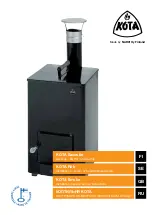
CHIMNEYS
Generally the most effective chimney is one that is
straight, avoid offsets, terminate with straight sided
pot.
Where the standard masonry chimney is not avail-
able, a proprietary type of 125mm (5”) twin wall, fully
insulated pipe may be used.
If it is necessary to offset the chimney, the recom-
mended angle is 60
o
to the horizontal and statutory
minimum is 45
o
. (See Fig. 4)
The flue must be high enough 4.5mts (15ft mini-
mum) to allow flue gases to vent into the clear air,
away from turbulence that may be caused by roof
structures, other chimney stacks etc. The venting
terminal position should be 1 meter (3’ 3”) above any
obstruction with a 7.6 meter (25’) radius.
FLUES
The chimney and flue pipes intended for use with
this appliance should be mechanically robust, resist-
ant to internal and external corrosion, non-com-
bustible, and durable under the conditions to which
they are likely to be subjected.
Flues require a suitable external terminal which
should be designed to permit easy ingress of com-
bustion products whilst providing protection against
the entry of rain, birds and other foreign matter into
the system. Flue pipes and accessories such as
clips and stays should not be made of unprotected
mild steel or other material which is likely to corrode.
Where flue piping passes through a closure plate
with a sliding door, ensure that the pipe continues up
and is ultimately connected to the flue liner and well
sealed with fire cement.
Do not connect to a chimney serving another appl-
iance. Always ensure that the connection is to a
chimney of the same size. Chimneys wholly con-
structed of single skin pipe are not recommended
under any circumstances. Due to their inability to
retain heat such chimneys will inevitably give rise to
the formation of condensation.
SUITABLE MATERIAL
*
Mineral Fibre cement pipes conforming to
B.S. 567.
*
Insulated metal chimneys conforming to
B.S. 4543 (a galvanised finish is not suit-
able).
*
Clay flue linings conforming to BS EN 1457.
*
Pre-cast concrete chimney blocks incorpo-
rated into the building structure. It is par-
ticularly important that the correct connec-
tion block be provided at the base of the
flue. B.S. 1289.
*
Cast Iron or acid resistant vitreous enamel
lined mild steel to B.S. 41.
Where twin wall pipes are of sheet metal construc-
tion the length of pipe located externally should not
exceed 1m (3’ 3”) unless it is readily accessible for
renewal.
CONNECTIONS
This appliance can either be connected to an
approved masonry chimney or gas flue. This appli-
ance may be connected either direct vertical or hor-
izontal.
A vertical cast iron outlet pipe with cleaning door is
available.
ALL FLUE CONNECTIONS MUST BE
THOROUGHLY SEALED.
Blocked chimneys are dangerous, keep chimneys
and flueways clean; read the operating instructions.
STANLEY CAST IRON PIPES AND BENDS ARE
HIGHLY RECOMMENDED FOR INTERIOR USE.
Where an appliance spigot or flue pipe protrudes
into the chimney, care should be taken to ensure
that it does not block the chimney.
NOTE:
Maximum horizontal length should not be
more than 300mm (12”).
DRAUGHT
While inadequate draught can seriously effect the
efficient operation of the appliance, chimneys over
18 ft. (5.4m) or houses built on high ground can
experience excessive draught.
Fig.4
NOTE: Never connect to a chimney or flue
system serving another appliance.
8









































